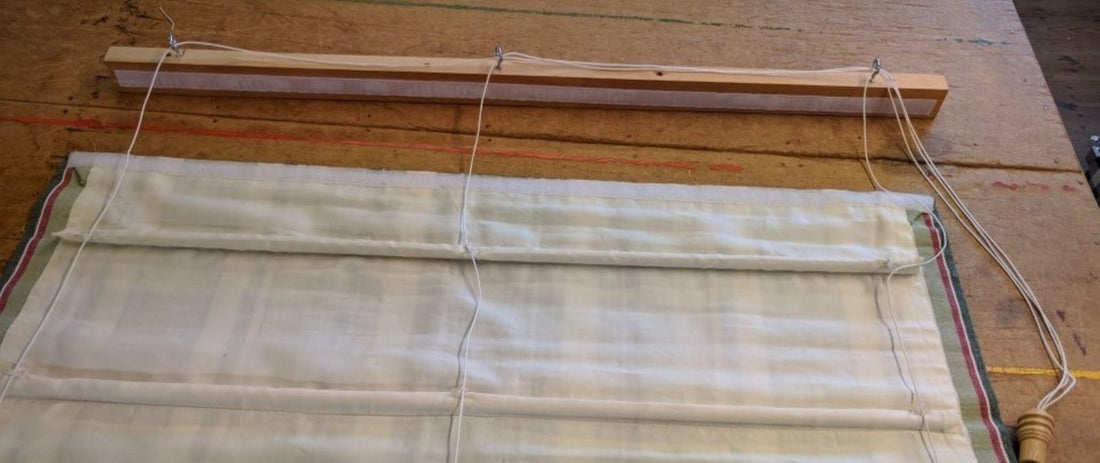
How to calculate components for a Roman blind
Roman Blind Components
Roman Blind Components
There are several components that make up the structure within a Roman blind that allow for smooth performance of its functions and effectively covering the window space.
Working with a basic 4 x 4 construction, where there are four horizontal folds and four vertical strings to pull the blind up and down, the following quantities of each individual components apply.
Of course the number of folds and strings will depend upon the width and length of the window and the style of the Roman blind itself in as much as how much light may be needed to enter the room from the window space.
See our tutorial on Calculating Fabric for Blinds before beginning this tutorial.
The list of components are as follows:
Lining - this will give body to the blind structure, will offer a neat outward face when closed and may offer some insulation (thermal lining fabric) or light reduction (blackout lining fabric) depending on the blind location and your individual needs.
Cleat - to anchor the strings that operate the opening and closing mechanism. it is fixed into the wall or window frame and can be purchased in different finishes such as nickel or gold, to co-ordinate with your hardware. You will need just one.

Acorn - the vessel, for the hand pull, into which the strings are finally threaded through and secured. This may be wood or metal or even plastic and come in a variety of styles. You will need just one.

Screw eyes - affixed to the wooden batten at the top of the window through which each of the strings run and are collected together on one side of the blind. For each string along the length of the blind you will need an eye. A four string blind will need four eyes. (You could also add an extra eye at the far end of the batten where the pull cords will be operated for all strings to run through)
Safety toggles - special fixings which the strings pass through on the bottom of the blind to prevent tangling in body parts and potentially causing injury, One for each string.

Plastic rings - positioned at intervals along each fold (rod/dowel) in parallel formation and through which the strings run from the bottom of the blind up to the top batten to smooth and regulate the movement of the strings when operating the blind. You will need 12 rings ; one for each string on each rod/dowel with the exception of the lowest dowel where there are safety devices instead.
Thread to sew the blind fabric together
Cording/string - you will need enough of the thin but strong roman blind cord, to run up the back of the blind in four seperate columns and along the top of the blind, through the screw eyes on the batten, then down the pull side of the blind.
The calculation is (length of blind x (width of blind x1.5) ) x number of strings
Dowels or Rods - either wooden or fibreglass which are cut to length and positioned at the back of the blind at each fold through the purposefully made channels, to give structure across the width of the blind. This allows the folds to collect together evenly, when the blind is opened. They will each need to be cut to just the width of the blind and in this instance you would need four.

Wooden Batten - attached to the wall or ceiling above the window and to which the Blind will be fixed. This is generally a 3cm x 3cm (or 1x1 inch) wooden batten, cut to the finished width of the blind.

Velcro - to be attached to both the face of the batten and the top of the inside of the blind which join together thereby fixing the blind, into position above the window. One side of this is a sew in piece to be attached to the blind, the other is a stick on piece to be attached to the wooden batten fixing. You will need both pieces to be the finished width of the blind.
Roman blinds can be fitted inside or outside of a recess
- Measure the width the blind needs to be
- Check which side the pully will be on
- Will the blind to be weighted with a bar?
You should have already calculated your fabric and lining before starting this calculation.
Header guidelines/rod spacing
Top channel should be 5cm/2" more than spacing between rods and bottom one, half size of the spaces.
Rods 30cm/12" apart - header 36cm/14"
Rods 20cm/8" apart - header 25cm/10"
Rods 15cm/6" apart - header 20cm/8"
How Many Strings?
Our guideline for number of strings is:
- Up to 100cm wide - 3 strings
- 100 - 140cm wide - 4 strings
- 140 - 200cm wide - 6 strings
We do not recommend making blinds more than 200cm wide, it would be preferable to have multiple smaller blinds to avoid sagging.
Calculating Roman blind cord
( Length of blind + (width of blind x1.5) ) x number of strings
e.g. (120cm + (180cm x1.5) ) x 4 = 15.6 metres of cord
Wooden Dowels
Wooden Dowels are 2.4m in length
For blind width 180cm you will need 1 dowel for each channel cut down to 180cm
For blind width 120cm a single dowel is cut into two @ 120cm for two channels
Buy pre-made pack
If this calculation seems daunting, we do have some pre-made packs for different sizes of roman blind. You will still need to purchase your wooden dowels and any wooden battens separately.
Large roman blind kit Medium roman blind kit Small roman blind kit
